

The food and beverage industry needs production facilities that have to work around the clock. A demand that must not be taken for granted.
And it applies to all the components of the plant: From the filling to the capping to the packaging line, all plant components, even smaller ones, must work reliably so as not to disrupt the entire production chain. High plant availability is a must.
Reliable production needs reliable power supply, which in turn should meet a well-maintained plant. All electrical currents should flow exclusively along the paths intended for them. The use of unwanted current paths is both undesirable and problematic, and ultimately dangerous for people and equipment.
Random, occasional measurements of the insulation resistance represent a snapshot and can feign security. But they certainly do not provide information about the availability of an installation. Not until monitoring devices are used that can measure and evaluate insulation conditions during operation and process and signal defined limit values can there be any talk of real system protection.
Even a correctly implemented installation is subject to wear and tear - especially in the food and beverage industry. The electrical insulation of the installation is particularly endangered by excessive contact with cleaning agents. The range of liquids alone that are used to remove labels, caps and also contaminants extends from relatively harmless water to aggressive cleaning liquids. This means an extremely high degree of stress for electrical insulation. Resulting insulation faults are only a matter of time.
Since all common materials for electrical insulation can only withstand the aggressive effects of etching and cleaning fluids at most in the medium term, their destruction is unavoidable in the long run. Spot-on maintenance is becoming extremely important. Through intelligent and continuous monitoring of the entire installation, emerging insulation faults are detected at an early stage. The benefit is obvious:Worn insulation can be replaced during service and maintenance work before serious malfunctions – even production downtimes – occur. Predictive maintenance is thus a result of complex analysis and coordination of power supply, protective measures, continuous monitoring and real-time messages.
The main circuit provides the energy for supplying the buildings and their lighting systems and drives (e.g. the conveyor belts). The required energy is transformed, transported, distributed and switched. It is designed either as an unearthed system (IT system) or earthed system (TN or TT ystem).
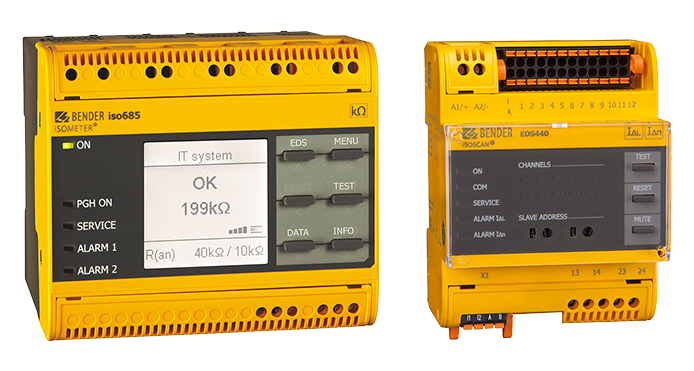
Especially in manufacturing, the IT system proves to be the better power supply to monitor due to its maximum availability. Since no active conductor is directly connected to earth, only a small fault current, essentially caused by the system leakage capacitance, flows in the event of an insulation fault. The upstream fuse does not respond, the power supply and thus continued operation remain guaranteed. Immediate information about a possible hazard is provided by an ISOMETER® insulation monitoring device from Bender. This makes continuous monitoring of the insulation condition during operation the standard – as well as a measurable reduction in maintenance effort (fully automatic instead of manual) and a reduction in costs. Another plus for the reliability of an electrical installation in IT systems is monitoring with additional insulation fault location. The ISOMETER® provides the necessary information advantage. Fast localisation is possible with an insulation fault location system, the EDS system from Bender. The location of the fault is signalled promptly during operation so that faults can be eliminated immediately and shutdowns can be prevented.
If an earthed power supply system (TN-S system) is installed, the solution is called continuous residual current monitoring – with residual current monitors of the RCM, RCMA or RCMS series from Bender. The total or residual current is continuously measured at particularly important or sensitive points in the system. If the residual or fault current critical for this part of the installation becomes too high, the residual current monitor issues an alarm. Installation technicians are then able to react immediately, so that shutdowns and plant standstills or even fires caused by insulation faults are a thing of the past – the strategy of predictive maintenance is fulfilled.
An integration of residual current monitoring is already possible with little effort, if measured data is collected at about 8 to 12 measuring points and the evaluation and information exchange is considered. The technical effort for predictive maintenance and thus enormous cost savings with significantly increased system and personnel safety is conceivably low. The space required for this can usually be found in existing control cabinets and does not require any complex new installations.
For control and auxiliary circuits in which, for example, commands are issued or measured, opened, locked, signalled, heated or cooled, the operational safety of the installation is paramount. The production line only runs when specific control voltages are applied.
The following applies to both system types: Insulation monitoring devices provide information in IT systems about the insulation state of the system. In TN-S systems, residual current monitors measure the insulation level and display it. The latest values can be read at any time, and inadmissible deteriorations are reported in good time.
For safe operation of installations, the most important task for operators and plant managers, there are numerous laws, regulations and standards that define the framework of safe operation. An essential aspect of this is the periodic verification of the electrical installation in accordance with DGUV Regulation 3. This can largely be carried out during operation (e.g. visual inspection) – with the exception of the insulation resistance measurement (cf. DIN VDE 0100-600:2008-06 Erection of low-voltage systems - Part 6 Tests:61.3.3 Insulation resistance of the electrical installation) and the measurement of the earthing resistance, both of which can only be carried out when the system is switched off.
However, switching off the power supply is often associated with high downtime costs and time-consuming restart of the installations, or is impossible altogether, as is the case, for example, in the complex installation parts of the food and beverage industry – from filling and capping to packaging systems.
However, standards such as DIN VDE 0105-100:2015-10 "Operation of electrical installations" and DGUV Regulation 3 "Electrical installations and equipment" offer two alternatives for the safe operation of installations that must always be available without switch-off:
Continuous monitoring of the insulation level of the electrical installation, according to the DIN VDE 0105-100:2015-10 standard, allows the electrically skilled person to adjust the test intervals for the periodic insulation measurement if this procedure is approved by the property insurer.
DGUV Regulation 3 also allows for the possibility of adjusting the time limits for verifications to maintain the proper condition of the installation by means of continuous monitoring.
In the IT system, it is therefore possible to continuously monitor the insulation resistance of the installation with an insulation monitoring device. Another option is the residual current monitoring system in the TN-S system, which continuously measures and evaluates the residual currents of the entire system. Deterioration of the insulation resistance is detected and reported. In both cases, a shutdown of the system for insulation resistance measurement is not necessary during periodic verification.
Of course, it is possible to communicate messages centrally with Bender monitoring systems in unearthed as well as in earthed systems. Whether via TCP/IP protocol to any network-compatible computer, by e-mail or via mobile phone – operating, warning or fault messages can be sent to almost any location. Early information about the cause and location of the fault makes it possible to carry out service interventions by the technicians in a cost-optimised manner and thus minimise consequential damage to expensive system parts or machines.
The web-based software solution POWERSCOUT® from Bender opens up new possibilities in predictive maintenance.
POWERSCOUT® provides an insight into the entire data of the installation at any time, since all measured values are stored automatically and continuously. It creates easily comprehensible visualisations not only for Bender measuring devices. It records data across locations. At the same time, it supports the analysis of the device data and thus documents the condition of the electrical installation. It can be individually adjusted to the customer's system and monitoring requirements.
This well-founded database allows us to show real trend curves. In this way, faults and interconnections are detected at an early stage and the causes are eliminated. In addition, POWERSCOUT® generates and saves the test protocols of the residual currents. This automated report forms the basis for measuring without switch-off by means of periodic verification.
Preventive maintenance strategies in the food and beverage industry through continuous monitoring of the power supply pay off several times over. They lead to reduced maintenance costs, reduce system damage, prevent machine failure, i.e. loss of margin, and fulfil the binding specifications according to DGUV Regulation 3.
Advantages of preventive maintenance with Bender monitoring systems at a glance:
| Name | Category | Size | Language | Timestamp | D-/B-Number |
|---|---|---|---|---|---|
| Product Overview ISOMETER®/ISOSCAN® | Product Overviews | 5.3 MB | EN | 2024/02/1616.02.2024 | |
| Product Overview - Residual Current Monitoring | Product Overviews | 8.0 MB | EN | 2025/04/0202.04.2025 | |
| Wiederkehrende Prüfung nach DGUV Vorschrift 3 (BGV A3) | Flyer | 535.0 KB | DE | 2024/07/0303.07.2024 | |
| Fachbeitrag: Produktionsstillstand muss nicht sein | Technical article | 1.4 MB | DE | 2020/04/1616.04.2020 | |
| Fachbeitrag: Hohe Betriebs- & Anlagenverfügbarkeit - Fehlerstromüberwachung | Technical article | 552.2 KB | DE | 2020/04/1616.04.2020 | |
| Fachbeitrag: Melden statt abschalten - vorbeugende Instandhaltung in der Getränkeindustrie | Technical article | 288.3 KB | DE | 2019/05/1313.05.2019 |
Products
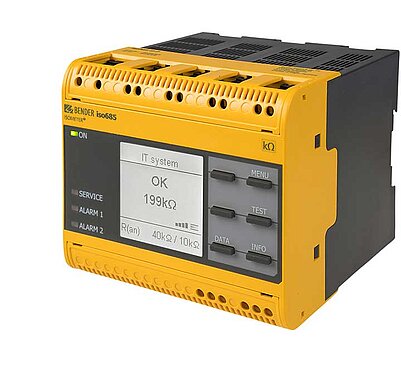
Insulation monitoring device for inverter applications and large industrial plants
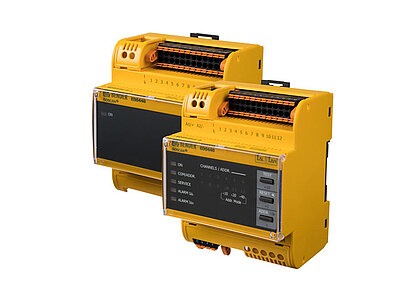
Insulation fault locator for localisation of insulation faults in main circuits
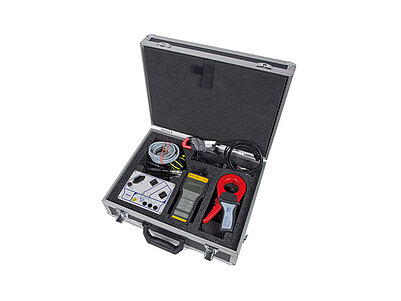
Portable insulation fault location systems for unearthed and earthed systems (IT and TN systems)
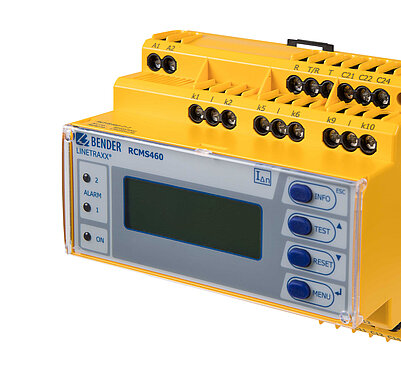
Multichannel AC, pulsed DC and AC/DC sensitive residual current monitor
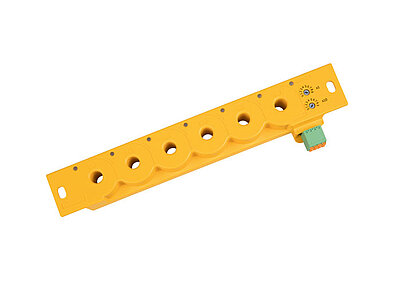
AC/DC sensitive residual current monitor (type B) with 6 integrated measuring current transformers
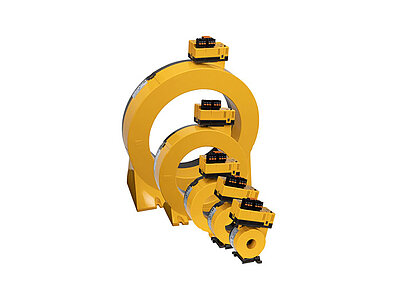
AC/DC sensitive residual current monitoring modules for MRCD applications
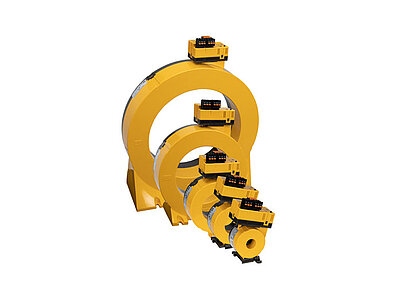
AC/DC sensitive residual current monitoring modules for monitoring applications
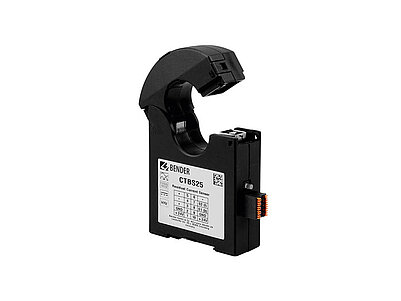
Split-core AC/DC sensitive measuring current transformer for converting system leakage and fault currents into evaluable measurement signals
![[Translate to English:] LINETRAXX® CTUB100 Series](/fileadmin/_processed_/0/d/csm_CTUB10x-CTBCx_WEB_SI_d8b0d156d2.jpg)
AC/DC sensitive measuring current transformer (Type B)

Recognising connections – optimising maintenance
![[Translate to English:] COMTRAXX® COM465IP](/fileadmin/_processed_/f/d/csm_COM465IP_01_WEB_296d1e7f5c.jpg)
Condition Monitor with an integrated gateway for the connection of Bender devices to Ethernet-TCP/IP networks

Insulation monitoring device for inverter applications and large industrial plants

Insulation fault locator for localisation of insulation faults in main circuits

Portable insulation fault location systems for unearthed and earthed systems (IT and TN systems)

Multichannel AC, pulsed DC and AC/DC sensitive residual current monitor

AC/DC sensitive residual current monitor (type B) with 6 integrated measuring current transformers

AC/DC sensitive residual current monitoring modules for MRCD applications

AC/DC sensitive residual current monitoring modules for monitoring applications

Split-core AC/DC sensitive measuring current transformer for converting system leakage and fault currents into evaluable measurement signals
![[Translate to English:] LINETRAXX® CTUB100 Series](/fileadmin/_processed_/0/d/csm_CTUB10x-CTBCx_WEB_SI_d8b0d156d2.jpg)
AC/DC sensitive measuring current transformer (Type B)

Recognising connections – optimising maintenance
![[Translate to English:] COMTRAXX® COM465IP](/fileadmin/_processed_/f/d/csm_COM465IP_01_WEB_296d1e7f5c.jpg)
Condition Monitor with an integrated gateway for the connection of Bender devices to Ethernet-TCP/IP networks